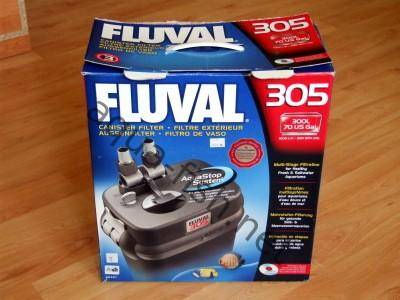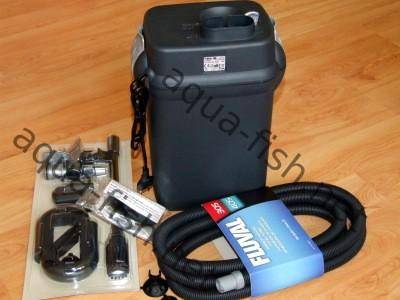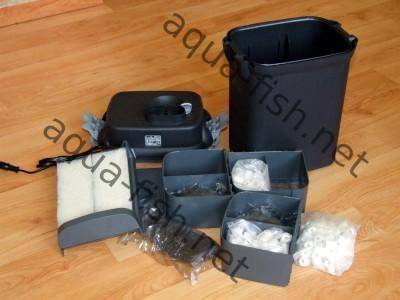Purpose of aquarium filters, types, media & advantages and disadvantages with forum
To clean the water of debris and suspended particles, remove ammonia and nitrites and aerate the water.
Quick navigation – Answers
Short introduction
Aquarium filters come in several types and each has its own pros and cons, each can be used for different purposes which is why we've published this article. In a case you're missing some information, or if you just want to ask or share knowledge feel free to submit your comments at the bottom of this page. Eventually if you'd like to purchase some filter, simply click this link.
How does it work?
Most aquarium filters are divided into three sections: Biological, Mechanical and Chemical.
Biological filtration
An aquarium filter is a breeding ground for two main types of bacteria. This is not something to worry about, quite the opposite. The type of bacteria that filters culture is specifically to work on the chemicals that fish produce through waste. The first type of bacteria breaks down the potentially very poisonous ammonia that fish produce into less harmful nitrites, and then a second type of bacteria breaks down the nitrites into even less harmful nitrates.
Mechanical
The filters will also remove large suspended particles of debris from the water.
Chemical
Some aquarium filters allow the addition of active carbon in the form of balls, sheets, wadding or crystals. The purpose of this is to remove medications and heavy metal traces from the water.
Aquarium filters come in several different forms, from Under-gravel filter trays, through Hang-on-back (HOB) filters and internal power-head filters to external "Sump" filters. All of them do very similar jobs and all work well. The main criterion for choosing which filter is best is the size of the tank and the load you are going to put it under. Let's take them one at a time and explain the benefits and drawbacks for each. I'll start with the cheapest and work upwards in cost:
Simple Air powered Filters:
Air-box and foam filters, which sucker onto the sides of the tank or just stand on the bottom and contain a filter media, foam or wadding to hold the bacteria and filter out the large debris.
These filters are very cheap, often costing just a couple of pounds. The principle of filtration is very simple, using an air stream to force the water through the filter. The principle use for these is in fry breeding, where you need a filter that doesn't cause strong currents and that won't pull the small fry into the internal workings. They also make ideal backup filters for other types and can be setup in minutes. You can even make your own filter like this out of bits and pieces you have laying around! If you have an air pump, you can use this type of filter.
Dis-advantages:
- Regular maintenance is a must. These filters can clog up with debris very quickly in heavy load situations.
- Not able to handle heavy filtration. These filters are not suitable for tanks where you have diggers, as they clog up very quickly and are limited on the amount of bacteria they can support.
- You need an air pump to run them.
Under-gravel Filter:
Out of all of the above, this is my personal favourite. Apart from anything else, it is the cheapest and simplest to maintain. Over the years, these have become less popular, mainly due to commercialism, not in-effectiveness. (Retailers make more money by selling more expensive options)
The filter works as follows:
It draws water down through the gravel across the entire bottom of the tank through small slots in the tray and forces the cleaned water back to the top through riser pipes in the corner of the tank using either an air stone or a power-head. The filtration is done by the gravel removing the larger particles and the bacteria that lives in the gravel and under the tray removing the harmful ammonia and nitrites. With the Active Carbon filter attachment fitted to the top of the risers, it will also remove heavy metals and medications from the water.
Advantages:
- It aerates the water by means of the air stone which draws the water up the riser or simply by the disturbance of the surface in the case of power-heads.
- It regulates the water temperature throughout the whole tank, simply by drawing the colder water from the bottom and pushing it out at the top. With the heater placed beside the riser pipe, this water is heated back up straight away, giving more even temperatures.
- It is flexible. By the addition of another riser pipe, the filter is capable of carrying a much larger bio-load, which is very helpful for over-stocked tanks. Most trays come with spare riser sockets to add more risers if required.
- It is a low-maintenance system. If you are pushed for time, this filter is very forgiving. It won't stop working over a short period of time and can be left for weeks without any concern.
- It is safe to use with very small fish. So long as the riser pipe is above water level this filter is very safe for smaller inhabitants.
- It is good in planted tanks. Plants can root through the gravel and into the slots in the tray to get a good hold.
- The cost is minimal. These filter trays are by far the cheapest alternative of all the filtration systems.
Dis-advantages:
- Cleaning: Can be difficult if not carried out regularly. (See the article on UGF cleaning for effective and quick ways to clean these filters.)
- Air Pump: You need an air pump powerful enough to run this filter effectively. It pays to buy a good air pump as if the pump stops, the filtration stops too.
- Substrate: You are restricted with the types of substrate you can use. Gravel is the only effective type of substrate for this filter. If you want to use sand, don't use this filter!
- Efficiency: The filter becomes less effective if not cleaned regularly. By regular, I mean at least every six months, which is a lot less than other filter types.
- Noise: The filter itself is silent, but sometimes the air pump the runs it can be noisy, so and the sound of bubbles bursting on the surface all the time can get annoying. Careful selection of the pump is very important.
Internal Power-head filters:
By far the most common system used today, these filters come in a range of sizes and shapes to suit most small to medium sizes tanks. They simply sucker onto the side or back of the tank and connect to mains power. The filter works through an impeller drawing the water through the filter media and forcing it back into the tank.
Advantages:
- Availability: There is a filter for most common sizes of tank.
- Simple to install: They can be fitted into a tank in seconds.
- Cleaning: The filters simply slide onto a bracket inside the tank, so removal for cleaning is easy. The media is contained in a removable section of the unit and can be made up of several elements, each one to do specific tasks. They can contain wadding, foam or crystals or a combination of any of the above. If they use foam pads, then you simply rinse them out and replace them when necessary, if they contain wadding, this can be rinsed a few times, but mostly requires replacement each time. Crystals will last for around 4 weeks at a time, then need replacing.
- Noise: Most of these filters run quietly.
For Axolotls keepers: Filters are essential when keeping Axolotls as they ensure the water is kept clean and provide an air supply for your Axolotl Tank which is a very important part of keeping Axolotls as it helps remove excess Axolotl pellets.
Dis-advantages:
- Looks: The physical size of the filter unit can be a problem if you want to hide it away. As it hangs inside the tank, it also takes up room and in a small tank, this could be a real nuisance. You need to take care when trying to hide it behind plants etc., as there must be clear passage for the water, otherwise it just won’t work!
- Cleaning: These filters must be cleaned regularly. They will clog up very quickly in high demand areas and become ineffective very quickly.
- Cost: They can be expensive to buy initially, especially the larger ones. The cost of maintenance can be high. Depending on the type of media used in the filter, it can get expensive to keep replacing media all the time.
- Water Currents: The current they create can be a problem. Some fish don’t like strong currents, and these fish do not do well in tanks with this type of filter. On the other hand, some fish love it! They also create a strong current at the intake, which can trap or even kill small fish and fry.
HOB or Canister Filters:
Hang on Back or Canister filters are becoming more common these days. I have prouped these two filters together since they are essentially very similar in performance and operation. They use two pipes that hang or clip over the back of the tank and water is pumped through the filter which can be on the back or anywhere away from the tank. Usually installed in a cupboard under the tank, but also wall-mountable. This type of filter contains lots of different types of media, depending on the manufacturer. Usually fairly expandable too, so individual choices of media can be made according to need. The recommendation for this type of filter is that it should be large enough to circulate ten times the volume of water per hour, which means that a 100 gallon (454.61 litre, 120.10 US gallon) tank requires a filter capable of moving 1000 gallons (4546.09 litre, 1200.95 US gallon) per hour!
Advantages:
- Power: These filters tend to be very powerful and move a great deal of water, capable of handling high demands on medium and larger tanks. Some are also adjustable so you control the power it uses.
- Effectiveness: For diggers and bottom dwellers they are very effective, since they clean large amounts of water very quickly. On most tanks where these filters are fitted, they give crystal-clear water all the time.
- Visibility: They are easy to hide away, since it is only the two pipes that enter the tank, and these are easy to disguise.
- Current: These units create a really strong current from both ends. The intake needs a good pre-filter fitted to stop the inhabitants being drawn in and the outlet creates a very strong circulation in the tank which is perfect for some fish, but not so good for others.
Dis-advantages:
- Cleaning: Can be difficult to clean and some need to be primed before they work. There have also been reports of flooding during the cleaning process, as when installed below the tank water level they can act as a siphon if the valves are not closed properly. Not so prone to clogging as they use lots of media.
- Cost: These are very expensive units, and maintenance costs can be high too, depending on the type you buy. The recommendations tend to insist on a much larger unit than you would expect to need.
- Noise: They can be quite noisy, the HOB filters especially, but canister filters can be installed away from the tank, this means that they can be put in another room if necessary.
Sumps:
Although these are not necessarily the most expensive to buy, I have put them last because they are by far the most adaptable, but need a lot of skill and patience to set up, and the cost is totally dependant on what you use.
A sump aquarium filter is a separate tank, usually a small 20 - 30 gallon (90.92 - 136.38 litre, 24.02 - 36.03 US gallon) fish tank, split into compartments for various uses. A sump is completely adaptable to suit individual requirements, and there are no real guidelines for this. Examples can range from a simple multi-stage filter, through internal heaters, live plants, biological additives, the list is almost endless.
Mainly fitted to the larger tanks, care needs to be taken in the planning, location, building and use intended. Most sumps are purely DIY and usually only attempted by experienced aquarists. Unless you have a real need for this type of filter, stay away from it!
Aquarium filters online
The following websites sell fish tank filters online, all links were valid on June 29th 2011. If any of them doesn't work, tell us, please! Use the form at the bottom of this page!





